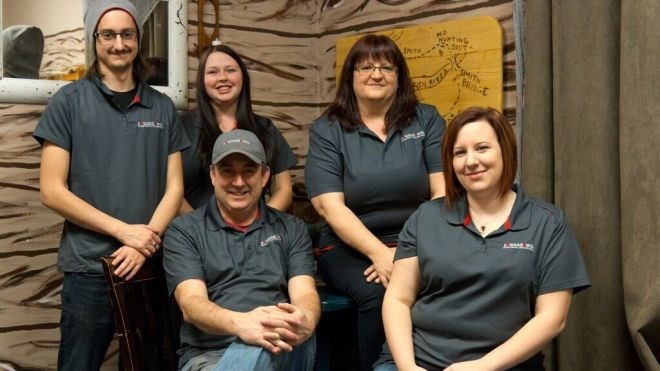Imagine this: you’re driving down a road, a dead cell phone at your side, when your car breaks down and you’re forced to go trudging through the woods seeking help. That’s when you come across a burly figure, looming ominously over a body.
To escape the clutches of this ‘mountain man,’ you run to a nearby cabin where the only way out is by solving a series of puzzles – within the hour, in the dark, and with only a flashlight to guide you.
It’s the premise behind The Cabin, one of five escape rooms, each with a different theme, offered by Countdown Escape Rooms, which was launched by Marcy and Mario Audet in Thunder Bay in October, 2015.
Countdown is part of a new trend of live, interactive strategy games, which challenge players to make their way through the room by solving a series of clues and puzzles until the final mystery is solved.
“It’s very interesting to see people in these rooms. I find it brings out different characteristics, especially when they’re working on a problem,” said Marcy, who comes up with the room concepts.
“Some people do it very team-like, and others want to take the puzzle and go off by themselves, or others get very angry and frustrated easily.”
The Audets were on vacation when they completed their first escape room and decided Thunder Bay needed its own version.
Both Marcy and Mario work full-time – she as a medical lab technologist and part-time instructor at Confederation College, and he running the diagnostic lab at LifeLabs – but they spend several hours a month writing storylines, gathering props and building their escape rooms all to offer customers an immersive, realistic experience.
Based on the “escape-the-room” videogames of the 1980s, live escape rooms started in Japan in the early 2000s before spreading to Europe and the U.K., and finally hitting North American shores some time around 2014.
Today, they’re billed as a fun way to spend time with family and friends, but are also becoming increasingly popular as a corporate teambuilding activity, which urges employees to work collaboratively to meet a common goal.
Mario, who has extensive leadership training, estimates 10 to 20 per cent of their clientele are businesses looking for teambuilding activities.
In order to effectively complete the room, team members have to communicate with each other and place their trust in the other members, which encourages creativity, strengthens relationships, and heightens problem-solving abilities, among other skills.
“It really works well,” Mario said. “It's kind of a fun thing to do where you can actually hone those skill sets, but yet it is an incredibly unique circumstance where you can take the team to a location and work on those skill sets and have fun doing it.”
Dave DeLoye and his family were backpacking through Budapest, Hungary, when they played their first escape room. By the time they completed the room, the family was hooked and DeLoye and his wife, Wanda, decided to bring back the activity to Sudbury. They opened Escape Artists in July, 2016.
The first room they developed, Berlin ’63, was based on U.S. President John F. Kennedy’s visit to Berlin, Germany, in June, 1963. The premise is that players comprise a team of West Berlin police officers who’ve found a KGB spy bunker in a tunnel underneath where JFK is set to deliver his speech, and they must thwart any planned attack on the president.
A current room, Chernobyl ’86, has players imagine they are recent graduates of the University of Kiev, and their first day of work is April 26, 1986 – the day of the devastating Chernobyl nuclear power plant explosion – and they have to work their way through the disaster.
Like the Audets, the DeLoye family operates Escape Artists in addition to working regular jobs. David works full-time in the IT department at Laurentian University and part-time with the Canadian Armed Forces, while Wanda is a part-time nurse. Yet, he estimates they put in between 70 and 80 hours a week developing their two escape rooms.
While they haven’t directly targeted the corporate market, DeLoye said it’s comprised a good chunk of his business.
In one example, after employees of a local investment firm completed a room, the manager intimated he was able to pick out which of his employees demonstrated the most leadership abilities and would be an ideal candidate for a management position.
“Leadership, problem-solving, communication, reaction under stress: all of the things he was looking for,” DeLoye said.
“He said they didn't even know that they were being assessed, and it certainly wasn't official, but it was one of those things where he was looking to see who was a natural leader in that comfortable, somewhat different environment.”
The Audets agree that when employees, and even the boss, are taken out of the work environment, they are often able to relax, demonstrating traits they might not always display while at work.
Mario said an astute employer will debrief employees after the room is complete, pointing out what worked and what didn’t, and using it as a jumping off point to improve everybody’s skills.
“You can leverage that (information) and unbeknownst to them, they’re developing good skill sets that are going to be beneficial to the company,” he said.
In Northern Ontario, there are companies offering the escape room experience in Thunder Bay, Sudbury (which has four), North Bay, and Sault Ste. Marie, and more are cropping up all the time.
For the non-corporate crowd, “escape room tourism” has also become popular, with visitors travelling to destinations around the province, country and even overseas to try out new escape room iterations. Some of DeLoye’s customers have completed upwards of 50 or 70 escape rooms around the world.
But he cautions people before partaking.
“Escape rooms are addictive,” he laughed. “Watch out.”




